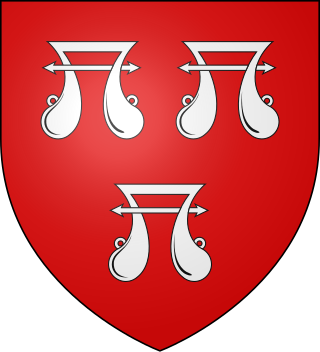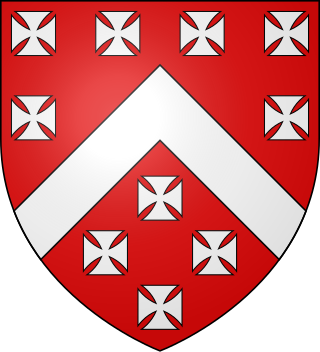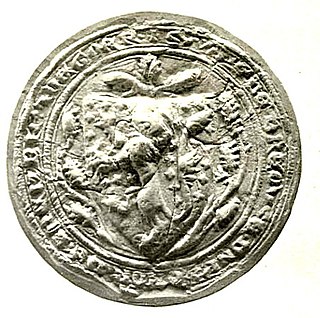
William Ros or Roos, 1st Baron Ros of Helmsley, was one of the claimants of the crown of Scotland in 1292 during the reign of Edward I.
The title Baron Bergavenny was created several times in the Peerage of England and once in the Peerage of Great Britain, all but the first being baronies created by error. Abergavenny is a market town in South East Wales with a castle established by the Norman lord Hamelin de Balun c. 1087.
Margaret of Norfolk or Margaret of Brotherton, Duchess of Norfolk in her own right, was the daughter and eventual sole heir of Thomas of Brotherton, eldest son of King Edward I of England by his second marriage. In 1338, she succeeded to the earldom of Norfolk and the office of Earl Marshal. In 1397, she was created Duchess of Norfolk for life.

The House of Mowbray was an Anglo-Norman noble house, derived from Montbray in Normandy and founded by Roger de Mowbray, son of Nigel d'Aubigny.

Wellow is a village in Nottinghamshire, England. According to the 2001 census it had a population of 444, increasing to 470 at the 2011 census, but falling slightly to 463 at the 2021 census.

Henry de Hastings of Ashill, Norfolk, was a supporter of Simon de Montfort in his rebellion against King Henry III. He led the Londoners at the Battle of Lewes in 1264, where he was taken prisoner, and fought at the Battle of Evesham in 1265, where de Montfort was killed. He resisted King Henry III's extensive siege of Kenilworth and after the Dictum of Kenilworth he commanded the last remnants of the baronial party when they made their last stand in the Isle of Ely, but submitted to the king in July 1267. In 1264 he was created a supposed baron by de Montfort, which title had no legal validity following the suppression of the revolt.

John (I) de Mowbray, 2nd Baron Mowbray was the son of Roger de Mowbray, 1st Baron Mowbray. Lord of the manors of Tanfield and Well, Yorkshire.

James Berkeley, 1st Baron Berkeley, also known as "James the Just", was an English peer.
John Hastings, 1st Baron Hastings, was an English landowner, soldier and administrator who was one of the Competitors for the Crown of Scotland in 1290 and signed and sealed the Barons' Letter of 1301. He was Lord of the Manor of Hunningham.

Walter de Lacy was lord of Meath in Ireland. He was also a substantial land owner in Weobley, Herefordshire, in Ludlow, Shropshire, in Ewyas Lacy in the Welsh Marches, and several lands in Normandy. He was the eldest son of Hugh de Lacy, a leading Cambro-Norman baron in the Norman invasion of Ireland, and Rohese of Monmouth.
This article is about the particular significance of the century 1201–1300 to Wales and its people.
Egidia de Lacy, Lady of Connacht, was a Cambro-Norman noblewoman, the wife of Richard Mór de Burgh, 1st Baron of Connaught and Strathearn (c.1180–1242), and the mother of his seven children, including Sir William Óg de Burgh, a lord and warrior and Walter de Burgh, the first Earl of Ulster. She was also known as Gille de Lacy. Egidia was the daughter of Walter II de Lacy by his second wife Margaret de Braose.
Maud de Lacy, Baroness Geneville was a Norman-Irish noblewoman and wealthy heiress who inherited half the estates of her grandfather Walter de Lacy, Lord of Meath, upon his death in 1241. The lordships of Trim and Ludlow passed to her second husband Sir Geoffrey de Geneville, 1st Baron Geneville by right of his marriage to her; although she helped to rule and administer the estates in an equal partnership. She is sometimes referred to as Matilda de Lacy.
Eleanor de Braose was a Cambro-Norman noblewoman and a wealthy co-heiress of her father, who was the powerful Marcher lord William de Braose, and of her mother, Eva Marshal, a co-heiress of the Earls of Pembroke. Her husband was Humphrey de Bohun, heir of the 2nd Earl of Hereford, by whom she had children, including Humphrey de Bohun, 3rd Earl of Hereford and Gilbert de Bohun.

William de Braose was the second Baron Braose, as well as Lord of Gower and Lord of Bramber. He was held as a hostage after being captured in 1264 during the Second Barons' War and records of some of his childhood expenses survive from his time as a hostage. He first entered royal service in 1286 and, in 1291, he succeeded his father as baron. He continued in royal military service, serving in Scotland as well as in Wales. Protracted disputes over his lands embroiled him throughout his life and at the end of his life helped spark a revolt against King Edward II of England's favourites, the Despensers. He married twice, and his heirs were his daughter Aline and his grandson John de Bohun.

From AD 1066, the feudal barony of Barnstaple was a large feudal barony with its caput at the town of Barnstaple in north Devon, England. It was one of eight feudal baronies in Devonshire which existed in the Middle Ages. In 1236 it comprised 56 knight's fees or individual member manors. The feudal service owed for half the barony in 1274 was the provision to the royal army of two knights or four sergeants for forty days per annum, later commuted to scutage.
The Lordship of Meath was an extensive seigneurial liberty in medieval Ireland that was awarded to Hugh de Lacy by King Henry II of England by the service of fifty knights and with almost royal authority. The Lordship was roughly co-extensive with the medieval kingdom of Meath. At its greatest extent, it included all of the modern counties of Fingal, Meath, Westmeath as well as parts of counties Cavan, Kildare, Longford, Louth and Offaly. The Lordship or fiefdom was imbued with privileges enjoyed in no other Irish liberty, including the four royal pleas of arson, forestalling, rape, and treasure trove.
Sir Ralph Hastings, third son of Sir Leonard Hastings, was a supporter of the House of York during the Wars of the Roses. He fought at the Battle of Barnet, and was knighted at the Battle of Tewkesbury. He held numerous offices during the reign of Edward IV, including Keeper of the Lions and Leopards in the Tower of London, and Lieutenant of Guisnes and Captain of Calais.
Hugh Hastings II, Lord of Elsing, Brisley and Grimston, was an English soldier and noble. He fought in the Hundred Years' War.

Hugh Hastings III, Lord of Elsing, Brisley and Grimston, was an English soldier and noble who fought in the Hundred Years' War.









